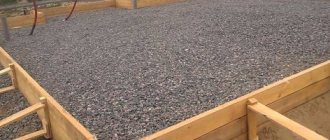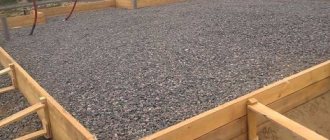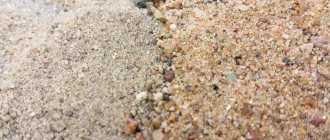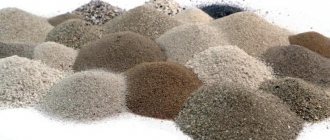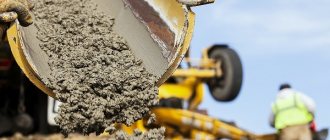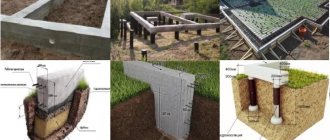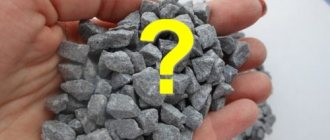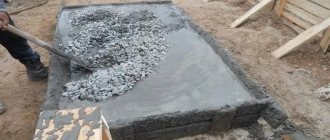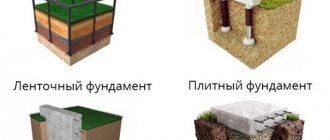At the initial stage of construction, when the excavation work is completed, they proceed to preparing the base of the foundation base. They make it at the bottom of dug trenches or pits. For small objects, it is better to form a pillow from sand. The question arises, how to choose the right sand for the foundation cushion?
Sand is a universal natural building material. It is a sedimentary rock consisting of grains of the mineral quartz.
The rock is divided into several modules of rock grain size:
- Large – from 2.5 to 3.5 mm;
- Medium – from 2 to 2.5 mm;
- Small – from 1.5 to 2 mm;
- Very small - from 1.5 to 0.7 mm.
The current legislation in Russia obliges all manufacturers of building materials, including sand minerals, to certify their products. Building materials are divided into three classes:
- Class 1 includes sands with a compressive strength of up to 30 MPa. Used for the manufacture of concrete and reinforced concrete structures;
- Class 2 includes material with a compressive strength of up to 20 MPa. Used for the manufacture of concrete and reinforced concrete products and other structures;
- Special grade 3 sand rock has a compressive strength of up to 40 MPa. It is used for the production of reinforced concrete products with high load-bearing capacity.
Sands, based on their natural origin and methods of extraction, are of several types:
Quarry sand
The mineral is mined in quarries using a mechanized method. This rock contains many inclusions in the form of stones and clay. Without additional processing, it can be used as. The quarry mineral is sifted or washed. Foreign impurities in the form of stones and clay particles are filtered out through a special sieve.
The rock is washed with plenty of water, washing out clay and other inclusions. Alluvial sand rock contains fine particles of about 0.6 mm. It can be used for plastering work.
I extract river minerals using floating dredges from the river bottom. This rock has better quality characteristics than other types of sand. The high quality and purity of the sand is due to natural purification by the river waters.
Like sea pebbles, the shape of sand grains of river rock is also rounded. Therefore, when using river sand as a foundation cushion, enhanced compaction of the sand layer will be required.
Sea sand
To use sea sand as a building material, it is subjected to double processing. First, in the process of sand extraction, foreign impurities are removed from it, then the rock is subjected to hydromechanical treatment.
The sea mineral is considered one of the highest quality. It is used in all areas of construction.
Crushed sand
Crushed sand is produced by crushing rocks with mechanical mills. Its cost is quite high, which is reflected in the price of the material.
The advantage of the material is the irregular shape of the grains of sand. This ensures a tight bond between the rock particles. When compacting, there is a slight decrease in the volume of the bedding, which reduces sand consumption.
sand cushion
The underlying layer of the foundation base is multifunctional in its purpose:
- The backfill under the base of the foundation levels the soil base of the trench or pit. It is imperative to arrange a sandy underlying layer under prefabricated reinforced concrete foundation blocks.
- The sand layer helps prevent foundation movements on weak heaving soils. Due to the backfill, the bearing capacity of the soil base increases.
- When the thickness of the sand bedding is more than 30 cm, the possibility of capillary penetration of moisture from the soil to the base of the building is interrupted.
- Sandy rock drains water better than other building materials, thereby protecting foundation structures from soil heaving. Without an additional drainage device, the mineral may silt up. Before starting construction, it is necessary to determine which drainage is best for the underlying layer of the foundation.
For the construction of the underlying layer, they try to use only coarse and medium sand. The sand layer protects against siltation by groundwater through waterproofing. When silting occurs, the underlying layer can turn into a heaving base.
Geotextile for cushion insulation
To avoid this, two layers of roofing material, polymer material, geotextile or other waterproof material are laid on the ground in dug trenches under the monolithic tape, at the bottom of the pit for the reinforced concrete slab. The developer decides what type of waterproofing to use.
If the embankment is of great height, then sand is poured under the foundation in layers 200 mm high. Each layer is moistened to increase the adhesion of sand grains.
Tamping the next layer of sand is mandatory. For this purpose, both an electromechanical vibrating plate and a rammer made from available material are used.
Tamping pillows
A manual tamper is easy to make. A double-sided handle is nailed to the top of the log, and a wide board 25–30 mm thick is attached to the bottom cut of the log. The height of the device should be comfortable for work.
The seal is considered to be of high quality when no shoe marks remain on the surface of the pillow. Watch the video on how to properly compact a sand cushion.
The thickness of the sand cushion is calculated taking into account the characteristics of the future structure and the quality of the soil foundation. In cross section, the pillow looks like a trapezoid. Its lower base should be one third wider than its upper part. Based on the length of the perimeter of the foundation strip and the area of the cross-section, determine how much sand is required. The extreme boundary of the underlying layer should protrude 100-200 mm from the vertical surface of the monolithic base.
On rocky, durable soils, small outbuildings do not require the construction of a special foundation. A sand foundation compacted with a hand tamper will withstand light loads.
From all of the above, you can understand what kind of sand and how much of it will be needed to construct a sand cushion for the foundation.
For the underlying layer of the foundation base, you can use: quarry, river, sea and crushed sand rocks, medium and coarse grain, first and second classes of compressive strength.
As well as foundations made of reinforced concrete blocks, it is customary to make a cushion of sand and/or crushed stone under their base. This pillow performs two important functions:
- Uniform distribution of foundation weight over the entire surface
. When preparing a pit for or a trench for a strip, the surface is never perfectly flat. Placing a sand cushion under the foundation levels the surface, smoothing out any unevenness in the ground. - Cutting off capillary moisture from the base of the foundation
. Thanks to this, soils can “raise” moisture upward: clayey ones by 1-1.5 m, and sandy ones by no more than 30 cm. Moisture at the base of the foundation is undesirable, since it can also penetrate concrete by capillary route, reach the reinforcement and cause its corrosion. A sand cushion (and even more so a cushion made of fine crushed stone) protects against capillary rise.
Features of clay soils
The main problem when designing a building on clay soil is frost uneven heaving. However, paragraph 5.9 of the set of rules SP 22.13330 of 2016 specifies measures to reduce the influence of deformations in soils on reinforced concrete structures intended for operation inside the soil.
The principle of frost heaving is as follows:
- soils contain particles of clay, which are saturated with moisture (rain, groundwater, melt water, wastewater);
- freezes to a certain depth in winter (not the same in different regions);
- water in the lenses of clay flakes increases in volume by 9%;
- soils tend to push out reinforced concrete structures located in them;
- or overturn them when forces are applied to the side faces of pillars, strips or piles.
The classic methods of protection against frost heaving are the following technologies:
- drainage - the installation of a circuit of perforated corrugated pipes along the perimeter of the foundation allows you to collect moisture and drain it by gravity into an underground reservoir;
- replacement of clayey soils with non-metallic material - natural soil is removed under the bottom of the tape, slab or pillar, an underlying layer of crushed stone and sand 40 - 80 cm thick is created (it will not work without drainage if water is saturated);
- insulation of the blind area and basement - used only for slab and strip foundations, it allows you to prevent freezing by preserving the geothermal heat of the subsoil;
- backfilling with the same inert materials that were used for the underlying layer (sand, crushed stone) eliminates pull-out forces from tangential loads on the side surfaces of pillars and strips.
Clays and loams by default have a high design resistance to prefabricated loads from the building. Therefore, the problem of shrinkage is completely absent. The issue of choosing a foundation is decided from the standpoint of the available budget and the need for a basement floor.
How to determine clay soil
After choosing the type of foundation (deep strip for the basement floor, MZLF for a brick cottage, pillars for a log house, piles for a dwelling on a slope), you need to order a geological survey of the site or do it yourself.
The clay content in a building spot can be determined without laboratory analysis:
- the clay rolls into a thin rope, the ball of it practically does not crack when squeezed with your fingers;
- Loam can be rolled into a thick rope (from 1 cm); when the ball is compressed, small cracks form on it.
None of these activities can be done with sandy loam, especially sand.
After which it is necessary to plan a set of works to prevent swelling, depending on the selected foundation:
- pillars - only below the freezing mark, drainage around the perimeter at the level of the sole, a foundation pit for each pillar, backfill layer thickness from 40 cm on all sides, the blind area is insulated only for a low grillage;
- tape - a full range of similar works;
- slab - insulation of the blind area over the drainage.
How to properly make a pillow under the foundation?
To construct a cushion, you need to use only coarse sand or small crushed stone (fractions 20-40 mm). Fine and dusty sand is not suitable due to its tendency to heave.
The pillow should serve as a good base, so it must be compacted thoroughly: pour wet sand in small layers 10-15 cm thick and compact it using a vibrating plate. When the layer is made thinner - 5-10 cm. To improve compaction, it is recommended to spill the sand with water, but this must be done before pouring it into the trench under the foundation, because in this case the water can erode the soil under the cushion, and this will reduce the load-bearing capacity ability and will lead to uneven shrinkage. In addition, washing the sand with water before filling it will remove small clay particles from it, which are completely unnecessary under the base of the foundation.
They lay it in a dug trench, which plays the role of a filter between the sand cushion and the surrounding soil and prevents the smallest particles of clay from getting into the sand, leading to its silting and further heaving.
Then the sand is laid in layers and compacted. Then they assemble it, lay a layer of waterproofing, install a reinforcement frame and fill it with concrete.
In general, the sand cushion under the strip foundation is shown in the figure.
Reinforcement
Laying reinforcement under the future foundation adds strength to the concrete being laid, turning it into reinforced concrete. Ordinary concrete withstands compression well, but does not withstand tension and bending well.
This disadvantage is corrected by reinforcement with rods and welded steel frames. Such a foundation does not respond to soil shrinkage and firmly holds the structure.
Reinforcing steel 12 mm – lightweight reinforcement, supplied in quarts. Reinforcement of greater thickness (heavy) is supplied in rods. Before pouring, lathing is performed: two types of reinforcement are connected by welding or twisting wire.
The rods are laid parallel in 10cm increments. Similar to them, but perpendicular, the next level of rods is laid. Each joint of the reinforcement is tied with galvanized wire. To do this you will need an automatic gun and a hook for manual dressing. A 20cm piece of wire is aligned with the rod, bent in half and tied. The ends are then threaded through the loop and tightened tightly with a hook.
When do you need a pillow under the foundation?
Despite the fact that the need for a sand cushion is rarely questioned, it turns out that it is not always necessary, and in some cases it will even be harmful.
Firstly, surrounded by dense soils with poor water permeability (clays, loams), the sand cushion will be less dense soil and all the water in the soil around will accumulate in it. Thus, the cushion actually protects against capillary moisture rising to the base of the foundation, but promotes the accumulation of rain or melt water. As a result, this leads to waterlogging of the soil under the foundation and reduces its bearing capacity. To prevent this from happening, you need to create a drainage system that will drain all this water.
Secondly, moisture in the soil is not only in the form of water, but also in the form of steam. The steam will easily pass through the sand bed and condense on the foundation. Therefore, from the point of view of protection from moisture, a sand cushion is not needed, since it does not solve all problems. In any case, you will have to use either waterproofing or moisture-resistant concrete.
Thirdly, uniform distribution of the entire weight over the surface, smoothing out soil unevenness is necessary only for prefabricated foundations, for example, a strip foundation made from FBS blocks. The surface of the trench has slight unevenness, because of this the block’s surface does not rest on the ground; there are voids underneath it.
The size of such voids is different, and when the foundation is loaded, shrinkage will occur, and it will be different for each block. Because of this, the blocks may move apart.
To prevent this from happening, you really need to make a sand cushion under such foundations: it will fill all the unevenness and evenly distribute the weight of each block.
However, in the case of monolithic strip foundations, a cushion is no longer needed: when poured, the concrete itself will fill all the unevenness of the ground, there will be no voids under the monolithic foundation, it will transfer the load to the ground with its entire surface, so it does not need a sand cushion.
To protect against moisture, it is more advisable to use either additives in concrete that increase its moisture resistance, or.
Types of soil mixed with clay
- Clay refers to soil in which at least 30% clay predominates.
- Loam is characterized by no more than 10% clay in the soil.
- Sandy loam contains from 5 to 10% clay.
There are also glacial clay and alluvial clay. The first type of this material is characterized by excellent load-bearing capacity. It is characterized by high strength under significant concrete loads.
But this ability is preserved only if it is deep.
Alluvial clay can be found near bodies of water. Due to its high plasticity, one should refrain from building on this site. It is not suitable for a foundation. Otherwise, it may soon float, which will cause cracks on the walls of the house.
As a last resort, building a house on stilts is allowed.
conclusions
- A sand cushion is needed when building block foundations.
- When pouring a monolithic foundation, a pillow is not needed
- When installing a sand cushion in clay soils, a drainage system is needed to remove water.
- The cushion itself does not protect the base of the foundation from moisture; For this you need hydro- and vapor barrier.
Sand-gravel or simply gravel pads are still made for all types of foundations, but their meaning is different - to compact the soil with crushed stone. Again, by itself, crushed stone poured under the base of the foundation does not give anything, but when it is compacted, each stone is driven into the ground and further compacts it.
If your plans for the foreseeable future include construction, you should carefully take into account all the details without exception, including the smallest and seemingly insignificant ones. The sand cushion under the foundation is no exception to the general rule. In this connection, you need to understand that not everyone can use sand for the foundation. Any builder knows perfectly well that this material differs in its markings. Accordingly, each type of construction work involves the use of one or another type of sand.
If you are looking for an answer to the question of what type of sand to use in order to get the highest quality sand and gravel bed, be prepared for the fact that there cannot be a specific answer. And the choice largely depends not so much on what material is used, quarry or river, but on a number of other factors. In particular, on the place of its extraction and quality characteristics.
Currently, purchasing sand is not particularly difficult. The number of companies from which you can buy it without any problems, and as much as you need, is quite large. But before you make a choice in favor of one or another seller, take into account some recommendations that will allow you to choose the most suitable river or quarry natural material.
As practice shows, the site where the foundation for a building or structure is planned to be constructed does not always have stable soil. And in this case, the pillow turns out to be necessary to make the shallow foundation stronger and, accordingly, better. In addition, the sand and gravel cushion under the foundation also performs some other significant functions:
- protects the foundation of the building from the destructive effects of groundwater;
- levels the area of upcoming construction;
- allows you to save due to the low cost of such building materials as sand.
A funny and sad story about ordering crushed stone
It turned out that ordering crushed stone and gravel in Georgia is a whole quest. We are not talking about all of Georgia; the situation is probably different in the regions. But this is how it turned out for us.
The first machine of "happiness"
Local friends helped us order building materials. If it weren't for their connections, it would have been even more difficult for us. Not only are they “new”, but the language barrier sometimes makes itself felt.
We arrived at the quarry and looked at the gravel. They pointed to the one they needed and asked: “Bring me such and such a size. And please try to have less sand. After all, we buy gravel, not sand.” But the delivery was carried out by a driver not associated with the quarry. A few days later they called us and said that the cards were aligned and everyone involved was able to ship and deliver gravel to us.
According to our plan, it should be like this: a car arrives, we tell the driver how to drive in and where, he drives in, pours gravel into the pit.
In reality: a MAZ car arrives, without any delay drives to the open gate and gets stuck right in the old drainage ditch at the very entrance to the site, 30 meters before the pit.
The driver runs out of the car, shouts something in Georgian, and waves his arms. Then he jumps into the back, pours gravel where he stands, and drives away. He finally shouted something about the tractor. Our friend translated that he advises hiring a tractor to drag stones into the pit.
To say that we were upset is to say nothing. 30 meters is a small distance for a car, but such a long distance for a person with a wheelbarrow and a load of several tons. But, of course, it’s their own fault, they didn’t realize that the ditch would become an obstacle.
A tractor is, of course, good. But first of all, where to look for it? “Okay, Google” doesn’t work here. Secondly, how much will it cost? It turns out that you have to pay twice for the delivery of gravel. Thirdly, he will make ruts for us all over the site, rainwater will stand in them, the earth will become loose, and no one else will definitely pass by us later.
Our friend assured us that everything would be fine with the tractor and went to try his luck in search. And we, sensing that waiting was just a waste of time for us, took up the wheelbarrow and shovel. It turned out that it was not in vain. The tractor was never found.
We have already experienced more than once that any losing situation has some positive meaning in the long term. The same thing happened here. Plunging a shovel into the eight-cubic-foot rock, we discovered that there was a lot of sand in the middle. This is exactly what we didn't need. If we had not dragged the gravel by hand, but poured all this stuff straight into the pit, we probably would not have noticed the sand, but there was half a cube of it there. In the future, it could be washed out through drainage ditches, and the foundation would begin to sag unevenly.
Everything that is not done is for the better. Even if “for the better” means moving 8 cubic meters of gravel by hand.
Sand and gravel mixture (SGM). In our case, it is not suitable for backfilling a pit.
Second car
We made the second order a day later. During this time, the first 8 cubes of gravel were already located in the pit. We removed the soft fertile layer of soil from the drainage ditch, filled the bottom with large cobblestones, and leveled the top with small stones. They reminded us to bring us clean gravel, without sand. In general, we prepared as best we could.
MAZ arrived, the driver is the same. They stopped him at the entrance and explained which way to approach the pit, where we had more solid soil. The driver listened, but stepped on the gas and almost got stuck. Fortunately, they managed to stop him and redirect him.
This operation was the most successful; gravel was poured as close as possible to the pit. True, there was again a lot of sand there and we had to separate the “wheat from the chaff.”
Third car
We were in a hurry, we scattered the first two cars in 4 days. 16 cubic meters of gravel with a fraction of 5-10 centimeters. Those who have ever encountered this will understand what it is like. There were good reasons for the rush; they really wanted to fill the pit before the rains. We were afraid that the rain would soften the ground and it would be even more difficult for heavy trucks to get to us. And after a good rainfall in our area, everything dries out in a few days.
But when we were ready, it turned out that the quarry would be able to ship crushed stone to us within a week at the earliest. This was due to the massive repair of roads in our area, all resources were directed there. It was difficult to come to terms with this, we learned about the delivery of crushed stone from the neighboring area, but they also seemed to be involved in road repairs.
Forecasters showed that the rains would continue for a week from Monday, and the crushed stone was supposed to be delivered on Sunday. And what do you think? The rain started on Sunday at 7am.
We understood that we were taking a risk, the car might not start, but we could not agree to a second week of downtime at the construction site. There was hope that the morning rain did not have time to critically wet the ground.
And now, again MAZ, again the same driver. It would seem that in two visits to us you can remember where to stop by and where not to. But we reminded you just in case.
However, our beloved Schumacher drove exactly where he shouldn’t, and, of course, got stuck. He again, like the first time, jumped out of the car and began waving his arms, shouting something in Georgian and looking at us as if we were the geniuses of the joints here.
We didn’t have the time or desire to figure out who the donkey was. We offered to dig up and put branches under the wheels, fortunately we have enough of this stuff on the site. To which Schumacher replied that this was all nonsense and did not allow us to do anything. He called someone and five minutes later his friend arrived in a KAMAZ. And a silent movie unfolds in front of us: KAMAZ and MAZ are standing, chatting about something, looking at us, laughing, it’s clear from their faces that our Schumacher is telling us what sheep we are, dragging the poor man into a quagmire. After a while they ask if we have a metal cable! To which we, of course, answer: “No!” If two truck drivers do not have a cable for such a case, then where will we get one in our empty lot? We don't even have a car! In response to our answer, Schumacher waved his hand, saying they didn’t even have a cable.
They called the authorities, and half an hour later he brought a cable and pulled out our poor fellow. We talked something about how difficult our area was, dumped the rubble behind the fence (even further than the first car), sympathized, smiled and went home. And we, accustomed to such a development of events, became sad for 5 minutes and began to transport crushed stone in a wheelbarrow.
A curtain.
The foundation cushion is made from coarse gravel and crushed stone.
Which sand is best to use?
As we have already found out, sand (both quarry and river) can be divided into several different fractions. The smallest of them is not used at all when performing work such as laying a foundation. Even if you are making a non-recessed version of the base for a light veranda or gazebo. This is due to the fact that the fine material will quickly settle, causing the pillow to lose its shape in a short time, causing the finished structure to warp.
Accordingly, in order for the foundation cushion to last as long as possible, it is better to use coarser sand.
Many experts in the field of construction agree that medium-fraction river sand is best suited as a cushion for a shallow foundation. However, if you use coarse sand, this will not affect the quality of construction work in any way.
As for quarry sand, its use is, in principle, also quite acceptable. But in its qualitative characteristics it differs significantly from river water. Therefore, many people prefer to act on the principle: why buy low-quality material if you can buy a higher quality one for not much more.
When choosing sand in order to install a cushion under the foundation, you should pay attention to the following points:
- if the material has a large number of clay inclusions, the solution made from such sand will not be strong enough;
- you need to choose one that is not too loose, but not too wet;
- Before use, the sand must be additionally sifted.
Advantages of using screw supports for foundation construction
When carrying out the work you will need the following tools:
- The well is made using a drill
- Special pipes for foundation
- Fine crushed stone or gravel
- Sand
- Water
- Reinforcing mesh or rods
- Concrete mortar
- Screw piles have a load-bearing capacity of several tons, so they are often used in the construction of residential buildings.
- Installation of structures does not require the use of heavy equipment and special devices. Installation can be carried out in heavily built-up areas.
- Piles can be driven into the ground at any time of the year. Installation speed is 1 – 3 days.
- The cost of work is lower than laying a strip and slab base.
The undeniable advantages of a screw foundation on clay soils make pile technology especially popular among summer residents and owners of wooden houses.
Why do you need sand for the foundation?
The installation of a sand cushion under the foundation is most often necessary in the following cases:
- In problematic soil conditions. For example, if construction is planned on heaving soil or peat, there is always a danger that the non-buried foundation will collapse or become distorted in a short time. The structure of the sand cushion allows the base to stand for a long period of time in the place where it is needed, while maintaining its own strength and integrity.
- Using a pillow allows you to interrupt the capillary communication, which is why the contact of moisture with the foundation completely stops.
How to compact sand correctly
Compacted sand is a material that is highly capable of resisting both tension and compression. Accordingly, such a process as compacting sand should be given especially close attention. In order for a non-buried foundation to be of high quality and durable, before starting work such as installing a sand cushion, you should make careful calculations, decide how much sand is required, and determine how thick the cushion should be in your particular case.
To complete the work you will need a building level and an ordinary tape measure. The first step is to make markings and dig a trench or foundation pit.
The bottom must be very carefully leveled and the soil thoroughly compacted.
After this, you can move on to the process of constructing the pillow itself. To do everything correctly, you need to pour a layer of sand, the thickness of which corresponds to the technology for laying a particular type of foundation. The material must be pre-wetted with water. This is necessary so that the density of the sand during compaction is as high as possible.
In some cases, it is allowed to use not pure sand, but mixed with gravel.
In this case, the thickness of the layer should not change. The easiest way to compact the material is to walk in your shoes on a layer of sand and trample it thoroughly. In addition, you can use a handheld vibrator. From special equipment you can use a vibrating plate. This will significantly speed up the process.
The thickness of each layer of sand should be no more than 200 mm. The minimum thickness cannot be less than 100 mm. And in this case, the pillow is used to level the base.
The maximum thickness of the sand cushion under the foundation is usually calculated based on the width of the foundation strip itself.
Device
The foundation pillow has a fairly simple design, which makes it possible to make it yourself. You can consider a typical scheme of a full-fledged, combined cushion, which is suitable for fairly heavy structures and weak soils.
The manufacturing technology is described by the following diagram:
- Digging a trench (pit).
- Leveling and compacting the surface layer of soil at the bottom of the trench. This creates a dense base.
- Laying geotextiles. This fabric does not disrupt the circulation of moisture, but prevents sand from migrating into the ground (washing out).
- Backfilling the sand layer with coarse-grained quartz sand. It is covered in layers with moistening and compaction. The minimum thickness of the sand layer is 20-25 cm.
- Filling with crushed stone or gravel up to 5 mm in size. The thickness of the layer is 15-20 cm. This element of the pillow increases strength and increases resistance to crushing. The layer is carefully compacted.
- Laying waterproofing. It is made of roofing felt or thick polymer film. Waterproofing should cover the entire surface of the pillow without gaps. An overlap of about 15-20 cm is provided at the joints.
When making a slab foundation, it is recommended to strengthen the cushion with an additional element - concrete preparation or footing. It not only increases the reliability of the base, but also helps reduce the consumption of mortar during the main pouring of concrete. The footing is made by pouring the so-called “lean” mortar from low-class concrete (up to B12.5).
Concrete pad under the slab
In some cases, the sand cushion under the base is replaced with concrete. The cushion under the slab has an increased load-bearing capacity, which allows it to be used on a wide variety of soils. There can be only one disadvantage of this layer - quite high cost. But in many situations, the question: “Why overpay if you can use a more budget-friendly sand option” does not arise due to the lack of an alternative.
The concrete pad under the slab can be further strengthened by reinforcement. For these purposes, you need a metal rod that will be used as reinforcement.
If you are planning to lay a shallow foundation, but do not know why you need a cushion and in what sequence to perform the necessary actions, it is better to use the help of experienced specialists.
We construct a pile and pile-screw type foundation for clay soils
For clay soils, a pile or pile-screw foundation is also used. In the first case, the supports are driven into the soil using special equipment, and in the second, the piles are screwed into the ground. This type of foundation has a number of advantages. When installed, the supports reach solid layers of soil, which provide increased structural strength and are not subject to deformation when the soil freezes.
The following are used as supporting elements of a pile foundation:
- drilled type columns. They are created by drilling, followed by installation of reinforcing mesh and concreting;
- metal piles of a screw design. They are made of pipes with a special tip and screwed tightly into the ground;
- reinforced concrete elements. They are driven into the soil using special equipment and are used for massive buildings.
Pile or pile-screw foundation is also used for clay soils
